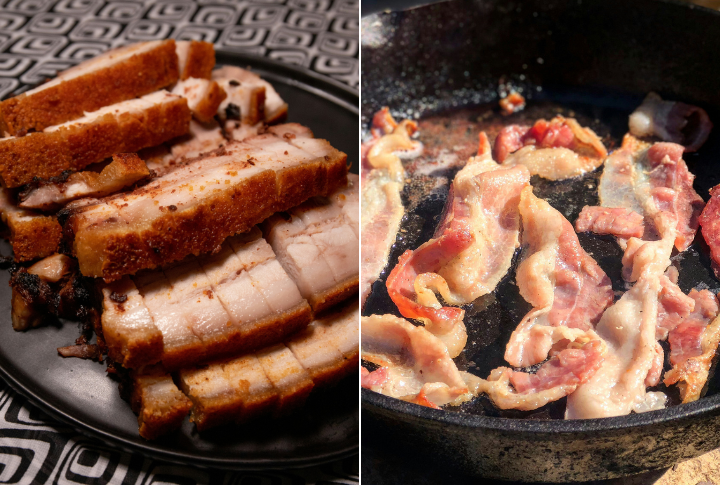
Pork belly and bacon are two beloved cuts of meat that often spark confusion due to their similarities in origin. Both come from the same part of the pig, but how they are treated and cooked sets them apart. Keep reading to learn about their distinctions, so you can make the most of their unique qualities in cooking.
Definition And Cut Of Meat

Both pork belly and bacon originate from the pig’s underside, but they diverge in how they are processed. Pork belly is a boneless cut, rich in fat and meat layers, typically sold uncooked. On the other hand, bacon starts as a pork belly but undergoes an additional transformation involving curing, smoking, and slicing.
Preparation Process

The preparation process is where the two cuts truly differentiate. Pork belly remains raw and is best when slow-cooked, whether roasted, grilled, or braised. Bacon, however, is first cured with salt and sugar, then smoked or air-dried, imparting its distinctive salty and smoky flavor.
Flavor Profile

The flavor of bacon is bold and pronounced—its saltiness and smokiness dominate the palate. In contrast, pork belly offers a richer, more decadent taste, with a fatty, melt-in-your-mouth texture when cooked slowly. It lacks the assertive smokiness of bacon but is equally indulgent in its own way.
Texture Comparison

Thanks to its high-fat content, pork belly has a luxuriously tender texture that becomes soft and juicy when slow-cooked. On the other hand, bacon delivers a satisfying crunch when cooked, with a crispy exterior and chewy interior. This is because of its thin slicing and rapid cooking method.
Cooking Methods

Pork belly is best when cooked low and slow in the oven, grill, or braise. This allows its rich fat to render and the meat to become meltingly tender. Bacon is typically cooked in a hot pan or oven, changing into a crispy snack in minutes.
Nutritional Differences

Both pork belly and bacon are high in fat, but their nutritional profiles diverge. Pork belly is generally richer in protein, and while it can contain more fat, the fat-to-protein ratio varies with cooking method. In contrast, Bacon’s curing process increases its sodium levels significantly and makes it less ideal for those watching their salt intake.
Price And Availability

Regarding price, pork belly can be more expensive per pound due to its whole-cut nature and the specialty handling required. Bacon is usually more affordable and accessible, often sold in convenient slices. Additionally, bacon is readily available at most supermarkets, but pork belly may necessitate a visit to a butcher.
Culinary Uses

In the kitchen, pork belly’s versatility shines. It’s widely used across various cuisines, especially in Asian dishes where it’s grilled, braised, or even incorporated into soups. Bacon, however, is most at home in Western breakfasts or as a flavorful addition to sandwiches and pasta.
Cultural Significance

Culturally, pork belly and bacon hold different places of reverence. In East Asia, pork belly is a comfort food, often featured in celebratory dishes like Korean samgyeopsal or Chinese braised pork belly. Conversely, bacon is a cornerstone of Western breakfast culture, symbolizing indulgence and influencing global food trends.
Shelf Life And Storage

Pork belly, being an uncooked and fresh cut of meat, has a relatively short shelf life and must be refrigerated or frozen to maintain its quality. On the other hand, bacon, due to its curing and smoking processes, has a longer shelf life and can be preserved in a refrigerator for weeks.
Leave a comment